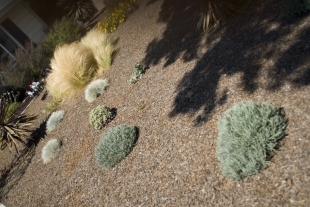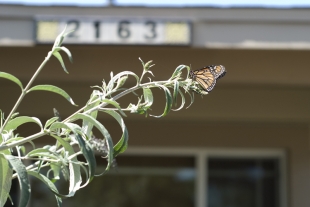Story by Stacy Fong
Photos by Christian Millan
 The state of California’s water crisis has motivated both state and local officials to require that residents reduce their water usage. These new regulations, as well as the “Green” movement and the current state of the economy have homeowners across the nation becoming proactive in cutting down on their water consumption.
The state of California’s water crisis has motivated both state and local officials to require that residents reduce their water usage. These new regulations, as well as the “Green” movement and the current state of the economy have homeowners across the nation becoming proactive in cutting down on their water consumption.
As part of the solution to the water shortage, drought-tolerant yards have become the latest trend for conserving water and lowering water bill expenses, and many Long Beach residents are embracing this new approach to yard maintenance.
Long Beach residents Richard and Rita Watty recently completed transforming their front lawn into a drought-tolerant yard after starting the transition in 2005 because they embrace both Green and cost-effective lifestyles. The look of the Wattys’ front yard is similar to ones you would traditionally see in desert climates. Rather than being dominantly green like a traditional lawn that you’d find in Southern California, their yard is prominently light brown because of the wood chips. Plants used in a drought-tolerant yard like the Wattys’ are those that require very little water. By transforming their yard, the Wattys were able to reduce their water consumption by two-thirds. This translated to a savings of about $23 per month.
A drought-tolerant yard requires very little water all year long, especially when compared to the irrigation needs of a traditional lawn. As a result of using such little water, these yards have an extremely low impact on the environment. According to the Los Angeles County Waterworks District’s Water Conservation Program, incorporating drought-tolerant plants into your yard can save hundreds of gallons each year for a single-family home. Instead of grass, the yards are covered with other materials like wood chips, with an assortment of drought-tolerant plants placed throughout the space. The Wattys yard has a beautiful assortment of drought-tolerant plants, such as purple sage, several different types of lavender, and even a licorice plant.
 This change requires a substantial financial investment up front, but has been estimated to create long-term financial savings and other benefits. The Wattys—who also use solar panels throughout their home as a source of energy—estimate that the total cost of their transformation was one dollar per square foot, with the biggest cost being their various types of drought-tolerant plants. The Wattys also hired a professional to remove the lawn, and once the sod was removed from the yard, Richard was able to convert his yard on his own with minimal guidance and research. His garden is fully maintained with a drip system, a highly efficient way to water your garden by using one hose with multiple water sources.
This change requires a substantial financial investment up front, but has been estimated to create long-term financial savings and other benefits. The Wattys—who also use solar panels throughout their home as a source of energy—estimate that the total cost of their transformation was one dollar per square foot, with the biggest cost being their various types of drought-tolerant plants. The Wattys also hired a professional to remove the lawn, and once the sod was removed from the yard, Richard was able to convert his yard on his own with minimal guidance and research. His garden is fully maintained with a drip system, a highly efficient way to water your garden by using one hose with multiple water sources.
The Long Beach Water Department has increased awareness of the threat of drought and the importance of water conservation. According to the LBWD, enough water has been taken from the critical supply reservoir to meet all of the City of Long Beach’s needs for more than 30 years. Consequently, serious measures have been taken to lower the city’s water consumption rate, including prohibiting previously common water usage habits and increasing awareness of the problem. Measures have been put into place in Long Beach, making it illegal to use too much water, or any water at all in ways that are now deemed wasteful.
 While the drought-tolerant yards may not suit all homes aesthetically, it can do a lot financially for homeowners. Modifying lawn care habits is one of the most effective things that can be done to reduce water consumption. If a complete yard transformation is too extravagant, there are also several other ways that “Green” practices can be incorporated into every home. Small changes—from shortening your showers to watering your lawn during the cooler parts of the day—are small yet efficient modifications you can make without even noticing any effort. To find out more information about local laws on water use, landscaping ideas and tips for saving water inside and outside the home, visit lbwater.org.
While the drought-tolerant yards may not suit all homes aesthetically, it can do a lot financially for homeowners. Modifying lawn care habits is one of the most effective things that can be done to reduce water consumption. If a complete yard transformation is too extravagant, there are also several other ways that “Green” practices can be incorporated into every home. Small changes—from shortening your showers to watering your lawn during the cooler parts of the day—are small yet efficient modifications you can make without even noticing any effort. To find out more information about local laws on water use, landscaping ideas and tips for saving water inside and outside the home, visit lbwater.org.

